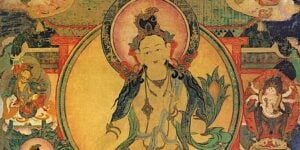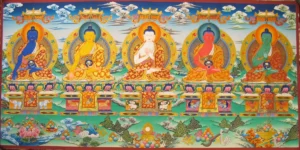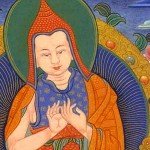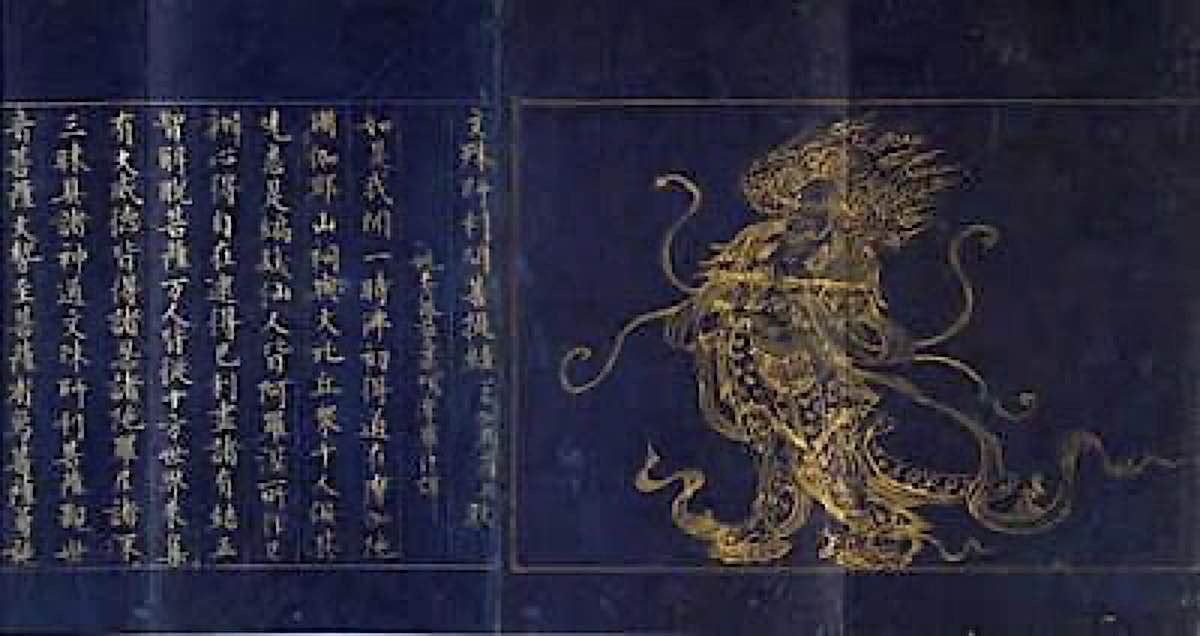What’s Your Karmic Net Worth? Avoid Compound Negative Karmic Interest with Vajrasattva Mantra and Four Opponent Powers.
Negative karma earns a sort of “compound interest” that rapidly accumulates if you don’t purify daily — not just ordinary interest, but usury levels a loan shark could appreciate. Even if you are generous and create endless merit each day, negative Karma can still — to use our analogy — bring us down to a negative Karmic “net worth.”
According to the Lama Zopa, Karmic debt like Usury:
“If you don’t purify it in this way your negative karma will keep doubling and re-doubling day by day, week by week, month by month, and year by year up to the end of your life and even one day’s negative karma will become as huge and heavy as a mountain—–in time, even one atom of unpurified negative karma can swell to the size of the Earth.” [1]
To make matters worse, it is virtually impossible to avoid negative karma day-to-day. According to the highly realized teacher Zasep Tulku Rinpoche, in explaining why we need Vajrasattva practices:
“When you walk, or when you drive a car, insects are crushed. Unintentionally, we hurt sentient beings. Or, even just eating food —– doesn’t matter whether you’re vegetarian or not —– you’re harming sentient beings, because the farmers, they kill some insects and animals. So, even if you’re a vegetarian, you’re still involved with killing. There’s no such thing as perfect livelihood. Nobody has that, as long as you’re living on this earth.” [4]
Although this sounds depressing, Vajrasattva practice (and other purification practices), are a remedy to these negative karmas we inevitably earn. With this simple practice, we can balance our karmic books.

Great Atisha Purified Immediately
Virtually all of the realized masters practiced purification. If it’s good enough for the great Atisha, it’s good enough for any Tibetan Buddhist. Atisha was famous for purifying any negative Karma immediately.
“Even in public or when riding his horse, as soon as he noticed a breach of his ethics, he would stop what he was doing, drop to one knee and then and there, purify it with the four opponent powers –– the powers of dependence, regret, remedy, and restraint.” [2] —– Gyoto Foundation.
Another famous story, is the story of the ant and Buddha’s disciple Nagarjuna. Even in the time of Buddha, one of his disciples accidentally stepped on an ant. Zasep Rinpoche, in a teaching on Vajrasattva, reassured students: “What can you do? Things like that happen. We create negative physical karma.” Vajrasattva practice “removes the negative karmas. You are purified.”
In Nagarjuna’s case, he purified this karma through his own death. In Tibetan Buddhism, using the four opponent powers, and especially Vajrasattva practice, there’s a less fatal way to purify past negative karmas.
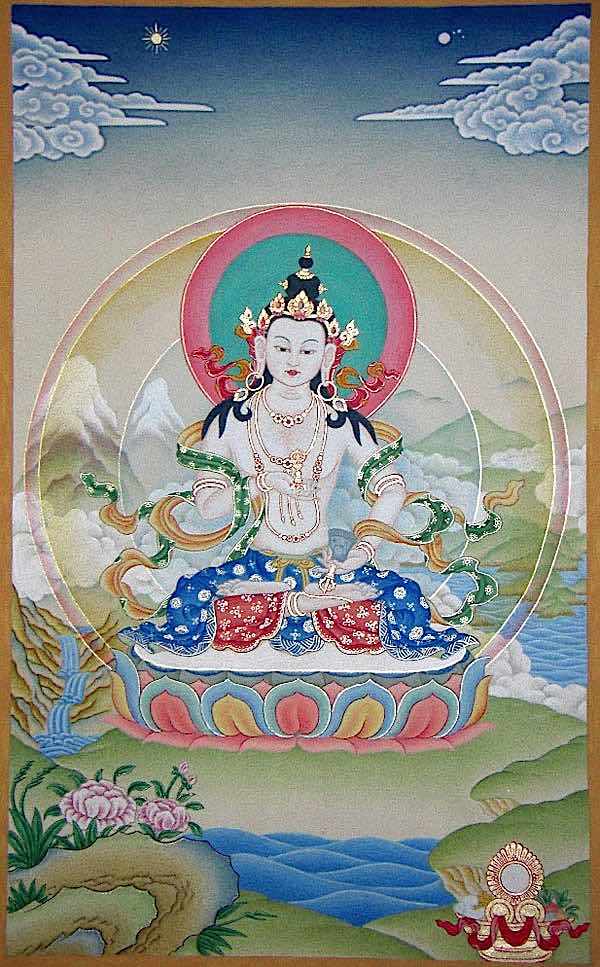
A Necessary Practice: All Schools of Tibetan Buddhism
“All schools of Tibetan Buddhism consider the preliminary practice of Vajrasattva to be necessary,” writes Rob Preece, a psychologist and teacher, in his book Preparing for Tantra.[3] Vajrasattva Practice, the best known method of practicing the “four opponent powers” — is taught by most Tibetan Buddhist teachers as one of the critical foundation practices — one we cannot do without. Each of the foundation practices — refuge, bodhichitta, prostrations, mandala offerings, Guru yoga, Vajrasattva practice — are designed, with precision, to target aspects of practice we all need, as Buddhists, to progress towards Enlightenment.
Gelek Rimpoche emphasized this point in his book Karma:
“We have to take care of all negative forces, no matter how small they may be, no matter how weak they be. If we don’t take care of them, they will have their result.” Yet there is a way to mitigate the negative effects. Rimpoche explained, “negative karmas can be washed away by applying the four powers.” [5]
Four Opponent Powers
Whether Buddhist or not, the four opponent powers are easily acknowledged as an “effective” method, from both a human — and a psychological — point of view, to remedy the harm caused by negative actions. The opponent powers, as described by Venerable Thubten Chodron, are:
- Regret: not to be confused with guilt. We acknowledge our responsibilities.
- Restoring the Relationship: After acknowledging, we restore our vow to not harm through taking Refuge and altruistic activities.
- Determination Not to Repeat: we make a promise to ourselves.
- Remedial Action: we try to mitigate or fix the harm. This can be apologies, altruistic acts, and purification practices such as Vajrasattva[6]

The order is often stated differently, as is the language. The great Lati Rinpoche gave the four opponent powers as:
- Power of Reliance
- Power of Regret
- Power of Antidote
- Power of Resolve.
Why is Vajsattva So Important?
Vajrasattva practice distills the key element of purification — the four opponent powers — and provides a powerful visualization and mantra focus to magnify those powers of regret.
Lama Zopa Rinpoche, in The Benefits of Vajrasattva Practice wrote:
“The Vajrasattva purification practice, which is more powerful than negative karma, can prevent you from experiencing the problems that negative karma would otherwise bring you. Thus, the practice of purification is one of the most important solutions to our problems and is extremely necessary, even for people who believe that we have only one life.” [1]
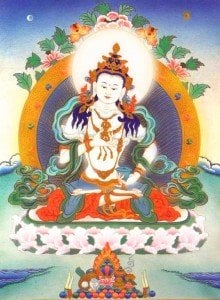
From a more psychological point-of-view, Rob Preece writes: “In order to cleanse the mind, we tap into an aspect of our innate purity, namely, Vajrasattva … when we understand this symbol, we see why this practice can be such a powerful and transformative process. It is like tapping into a natural source of health and using it to burn away sickness. It is like lighting a powerful fire of brilliant white heat that burns away the darkness of obscuration from the mind.”
Arguably, Vajrasattva practice could be the most important of foundation practices, since. Even if we’re accumulating vast merit (achieved through altruism, Bodhichitta and Mandala offerings, for example), we still have to deal with the laws of “cause and effect” — karma. To use a real world example, even if we’re earning lots of money, we still have to pay down our debts to realize stability. In Vajrayana, progress in practice relies on purification of negative karma (paying down the debt). Both Ngondro (foundation practices) and Lamrim teachings stress the importance of working on Vajrasattva purification every day.
Chanting the Vajrasattva Mantra is a powerful purifying practice. (See mantra text below):
When to Do Vajrasattva Practice
As Lama Zopa Rinpoche advised, every day before bed, we should do a Vajrasattva meditation to purify any of the day’s negativities — such as the ant we stepped on in our garden.
For the serious student, as a foundation practice in Vajrayana, the teacher might ask you to do a formal retreat, to purify all past negativities. This would involved 100,000 repetitions of the long Vajrasattva mantra while visualizing purifying energy entering the body. Purification, combined with intention and visualization is a potent combination.
Lama Yeshe once explained to Rob Preece why he should do a Vajrasattva retreat:
“If you just get a taste of the mind’s clear nature, then it is so worthwhile.” [3]
For any student with a Yidam practice, normally a Vajrasattva recitation is included in the Sadhana’s to “compensate for any mistakes.”
The ultimate answer is, anywhere, anytime. There isn’t a day that passes where a human being unintentionally accumulates little negative karmic accumulations. Reciting the 100 syllable Vajrasattva mantra while driving or in the shower or on a walk (where you might step on that ant!) — all are appropriate.
How Does It Work: Purification Visualization and Meditation
Psychologically, Vajrasattva practice is soundly based. Firstly, the four Rs of Regret, Restoring, not Repeating and Remedial action are very firmly grounded in psychology.
In addition to the four Rs, in common with all Vajrayana practices, the visualization of Vajrasattva (often in union with his consort, representing the union of compassion and wisdom) is ultimately based on “emptiness.” Most deities arise in our minds from emptiness. Ultimately, where there is emptiness, there are no afflictions, no obscurations, no negative Karmas.

Vajrayana practice, at one level, is all about helping deconstruct our incorrect assumptions about the nature of reality. In doing so, as we come to realize that all things are interdependent and ultimately empty of a true self, we remove attachments and afflictions — the cause of our negative karmas.
The Six Remedial Actions
Vajrasattva practice is only one of the possible remedial actions. At one level, purification arises from positive actions — at least the remedial action aspect. In other words, as long as we regret, restore and vow not to repeat, any positive action can provide the remedial action.
The six recommended remedial actions are:
- Reciting Sutras or Tantras
- Reciting mantras
- Meditating on emptiness
- Creating sacred art such as statues or thangkas
- Making offerings to the Three Jewels
- Reciting the names of the Buddhas, as in the practice of 35 Buddhas.
The supreme method, Vajrasattva practice, includes elements of all six. You recite, meditate on emptiness, contemplate sacred art, make offerings, and recite the name of Buddhas (Vajrasattva and consort).
Venerable Thubten Chodron said, in a talk on Negative Karma,
“These are six remedial actions that are specifically spelt out, but in actual fact, any positive action we do—reading a Dharma book, coming to class, studying, doing some meditation, doing community service—–they all become remedial actions. Lama Zopa was saying one of the best ways to purify is to take precepts, because if you take a precept not to do something, then you are actively not doing it and you’re purifying that negative karma.” [6]
Listen to Teachings on the Essence of Vajrasattva from Khenpo Sherab Sangpo:
Some Practice Suggestions
There are many ways to practice purification. Vajrasattva practice also can be practiced in different ways, as long as, somehow, we combined the four powers.
The most basic suggestion is to simply think of regret, take refuge, vow not to repeat and then apply one remedial action, such as the mantra of Vajrasattva. Below, is Vajrasattva’s 100 syllable mantra (which should be recited at least 21 times, preferably more). The version here includes the English interpretations as suggested by the Bodhicitta Sangha: [7]
oṃ Vajrasattva
The most excellent exclamation of praise, the qualities of Buddha’s holy body, speech, and mind; all that is precious and auspicious. Vajrasattva, you whose wisdom is inseparable bliss-emptiness,samayam anupālaya
And whose pledge must not be transgressed, lead me along the path you took to enlightenment,vajrasattva tvenopatiṣṭha
Make me abide close to your holy vajra mind,dṛḍho me bhava
Please grant me a firm and stable realization of the ultimate nature of phenomena,sutoṣyo me bhava
Please grant me the blessing of being extremely pleased and satisfied with me,supoṣyo me bhava
Bless me with the nature of well-developed great bliss,anurakto me bhava
Bless me with the nature of love that leads me to your state,sarvasiddhiṃ me prayaccha
Please grant me all-powerful attainments,sarvakarmasu ca me cittaṃ śreyaḥ kuru
Please grant me all virtuous actions and your glorious qualities,hūṃ
Seed syllable of the vajra holy mind, the heart essence and seed syllable of Vajrasattva,ha ha ha ha hoḥ
Seed syllables of the four immeasurables, the four empowerments, the four joys, the four kayas, and the five wisdoms,bhagavan sarvatathāgatavajra
You, who are the vajra of all who have destroyed every obscuration, of all who have attained all realizations, of all who have passed beyond suffering, and of all who have realized emptiness and know things just as they are,mā me muñca
Do not abandon me,
vajrī bhava
Grant me the nature of indestructible union, the realization of your vajra nature,mahāsamayasattva
You, the great pledge being with the holy vajra mind,āḥ
Make me one with you.
Syllable of uniting in non-duality.hūṃ
Syllable of the wisdom of great bliss.phat
Syllable that clarifies the wisdom of inseparable bliss-emptiness and destroys the dualistic mind that obstructs realization.
Body, Speech and Mind
In more formal Vajrasattva practice, we visualize purifying karmas of the body, karmas of the speech and karmas of the mind:
- Karma of the body: our negative actions, such as killing an insect
- Karma of the speech: saying negative things, insulting someone, speaking in anger
- Karma of mind: even if you hold your tongue, thinking negative thoughts.
By incorporating the four powers into practice, we definitely involve the mind. Mantra definitely adds in the element of speech. Visualization, typically, is meant to help purify the body.
How does visualization purify body? His Eminence Jamgon Kongtrul Rinpoche the Third put it this way: “What is the purpose of Vajrayana practice? Purifying one’s impure perception of all appearances and experiences.”
When practicing Vajrayana visualization, the visualized Enlightened Being arises from emptiness, helping us understand the all-important concept of Sunyata.
“When you do these practices, this “I” —– ordinary man or woman ego —– is already gone,” said His Eminence Zasep Tulku Rinpoche. [8]
A Simple Visualization Practice of Vajrasattva
The simplest complete Vajrasattva practice would include refuge in the Three Jewels, a statement of regret, a vow not to repeat, a visualization of Vajrasattva and a glorious glowing white deity, and the mantra. As the mantra is chanted, we visualize glowing white light (or white nectar) flowing from Vajrasattva’s Holy body into our own. Alternately, in more advanced practices, Vajrasattva would be in union with his consort, representing Emtpiness and Wisdom. As the white light fills us, negativities, visualized as dark smoke, or sludge, or any negative substance, is expelled.
The visualization is not disimilar to visualization practices used in the treatment of diseases such as Cancer. These meditations have proven in various trials, to be effective for some people. In these meditation, the cancer is visualized as “burned up” or expelled by white light.
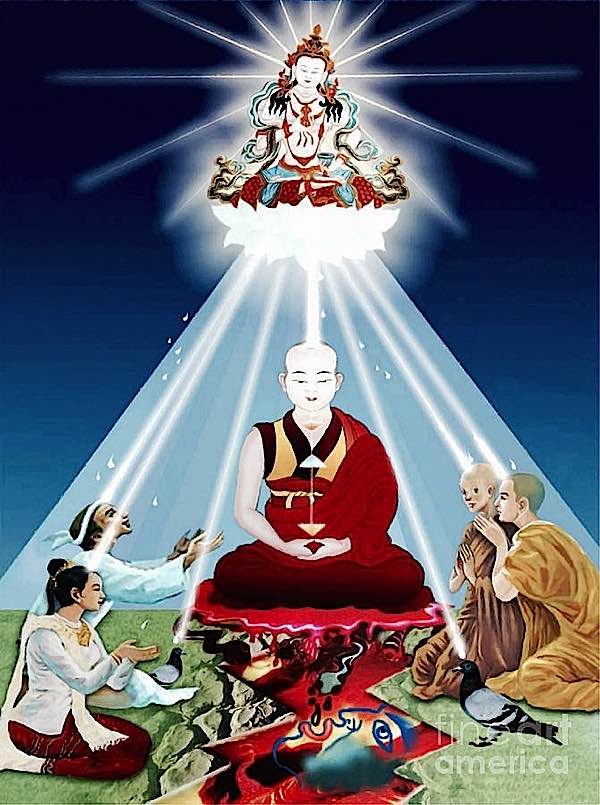
To embellish slightly, the practice is expended into:
- Expelling downward: negativities expelled through feet, cleansing the Body
- Expelling upward: negativities expelled through mouth, by filling up the body from bottom to top (like filling a glass), cleansing the Speech
- Expelling spontaneously: white light or nectar fills your heart, then your entire body, with the negativities disintegrated by the light — which cleanses the Mind.
For example, as recommended by the great Lati Rinpoche, expelling downwards can be thought of this way:
“Imagine the nectars and light rays descend from above through your body. They flow down and wash away all the negativities of your body and obscurations in the form of black, ink-like liquids that come out of the anus, the secret organ, and from the pores of your body. Illness in the form of blood, phlegm and pus and harmful spirits, and interfering forces in the form of frightening animals like scorpions and snakes come out from the orifices of the lower part of your body. When a volcano erupts, the lava washes away all the trees and things in that place. Likewise, the nectar forcefully washes away all negativities.”
Sadhana: Words Have Power Over Our Own Minds
Typically, we speak our intentions aloud in Buddhist practice, recognizing the power of Speech. By combining some of the purifying visualizations above, we can add words to empower our practice of purification. As recommended by Venerable Thubton Chodron: [10]
While visualizing Vajrasattva (refer to embedded images) as a divine white glowing body made of light say the refuge three times:
I take refuge in the Three Jewels. I will liberate all sentient beings and lead them to enlightenment. Thus, I perfectly generate the mind dedicated to attaining enlightenment for the benefit of all sentient beings.
Then, express the power of regret, by making a request of Vajrasattva:
O Bhagavan Vajrasattva, please clear away all negative karma and obscurations of myself and all living beings and purify all degenerated and broken commitments.
To include the power of remedial action, visualize purifying light or nector streaming from Vajrasattva, into you, purifying the negativities, while chanting the 100 syllable mantra (below is Tibetan pronunciation, Sanskrit is above):
om vajrasattva samaya manu palaya
vajrasattva deno patita
dido may bhawa
suto kayo may bhawa
supo kayo may bhawa
anu rakto may bhawa
sarwa siddhi mempar yatsa
sarwa karma su tsa may
tsitam shriyam kuru hum
ha ha ha ha ho bhagawan
sarwa tatagata
vajra ma may mu tsa
vajra bhawa maha samaya sattva
ah hum pey
If you have trouble with this, or have not yet memorized it, use the short version (many times!):
Om Vajrasattva Hum
Then finish with the power of determination by directly addressing Vajrasattva:
Through ignorance and delusion I have broken and degenerated my commitments. O spiritual master be my protector and refuge. Lord, Holder of the Vajra, endowed with great compassion, in you, the foremost of beings, I take refuge. I shall do my best not to do these destructive actions again in the future.
Finally, as always in Buddhist practice, it is critical to seal the practice with a dedication (and visualize absorbing Vajrasattva into your heart as a stream of white light):
Due to this merit may we soon
Attain the enlightened state of Vajrasattva,
That we may be able to liberate
All sentient beings from their sufferings.
May the precious bodhi mind
Not yet born arise and grow.
May that born have no decline,
But increase forever more.
NOTES
[1] Lama Zopa Rinpoche, in The Benefits of Vajrasattva Practice
[2] Vajrasattva Practice, Gyoto Foundation
[3] Preparing for Tantra: Creating the Psychological Ground for Practice, Rob Preece, Snow Lion (Sept. 16 2011) ISBN-10: 1559393777, ISBN-13: 978-1559393775
[4] Vajrayogini Teachings, 11 Yogas of Vajrayogini, Zasep Tulku Rinpoche, Dec 3, 2016.
[5] Karma, by Gelek Rimpoche, published by Jewel Heart, ISBN 1934994146, 9781934994146
[6] The Four Opponent Powers, Thubten Chodron
[7] Bodhicitta Sangha Heart of Enlightenment Institute
[8] Interview with Zasep Tulku Rinpoche in Buddha Weekly
[9] The Lightning Path of Buddhism Buddha Weekly
[10] Vajrasattva Sadhana, Thubten Chodron
Latest Features
Please support the "Spread the Dharma" mission as one of our heroic Dharma Supporting Members, or with a one-time donation.
Please Help Support the “Spread the Dharma” Mission!

Be a part of the noble mission as a supporting member or a patron, or a volunteer contributor of content.
The power of Dharma to help sentient beings, in part, lies in ensuring access to Buddha’s precious Dharma — the mission of Buddha Weekly. We can’t do it without you!
A non-profit association since 2007, Buddha Weekly published many feature articles, videos, and, podcasts. Please consider supporting the mission to preserve and “Spread the Dharma." Your support as either a patron or a supporting member helps defray the high costs of producing quality Dharma content. Thank you! Learn more here, or become one of our super karma heroes on Patreon.
Josephine Nolan
Author | Buddha Weekly
Josephine Nolan is an editor and contributing feature writer for several online publications, including EDI Weekly and Buddha Weekly.



